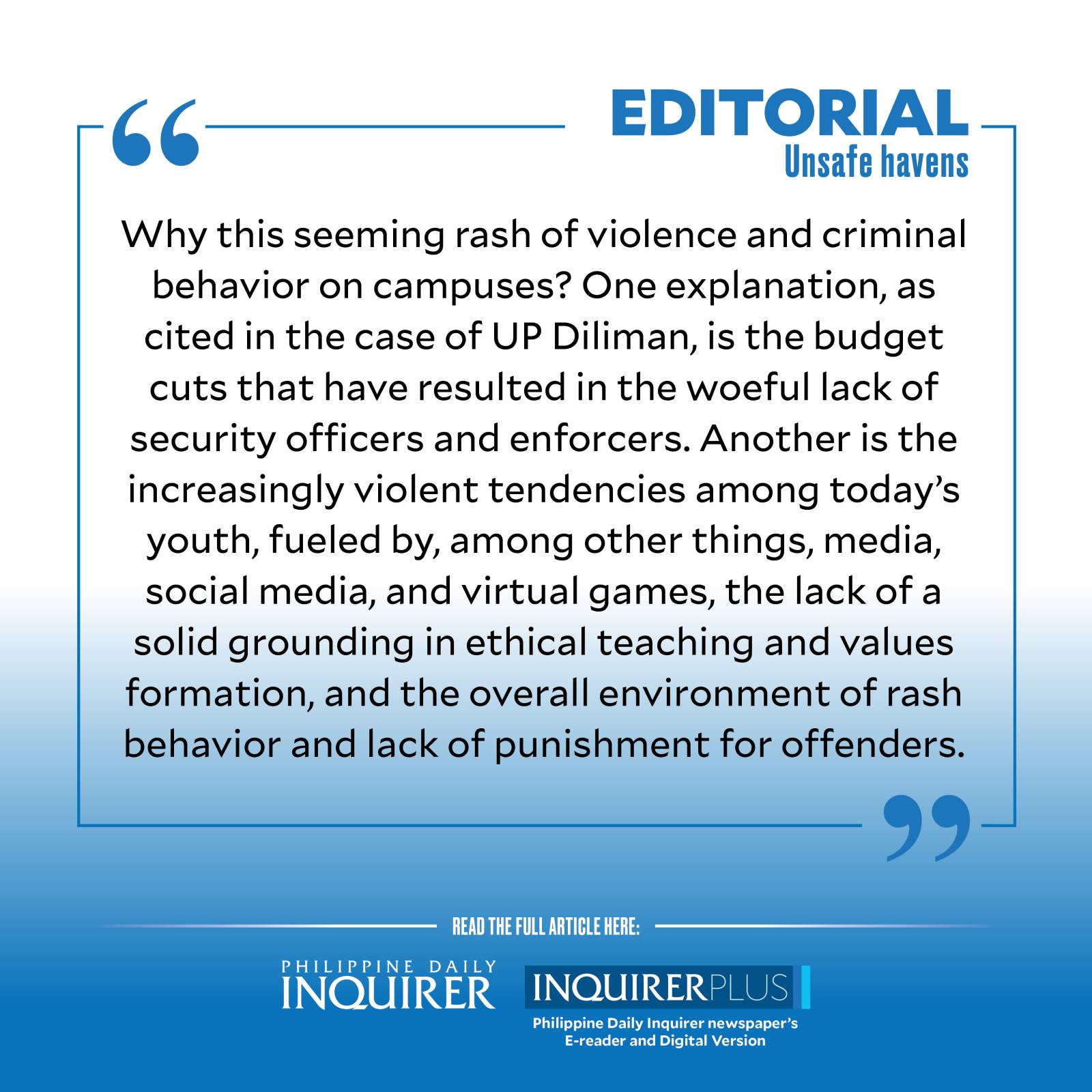
“Bucolic” is a word often used to describe the campus of the University of the Philippines (UP) Diliman, with its canopies of trees, greenery, quiet, and tranquility.
But for a female college student, that notion was shattered last week, when a man armed with a knife sexually assaulted her. This took place late at night last Saturday at a vacant lot in the sprawling campus.
In reaction, UP Diliman Chancellor Edgardo Vistan II said security measures on the campus would be reviewed, while more campus police would be deployed to “areas with a history of being dangerous.” He added that “We want to assure the community that we are very conscious about their safety and security. We know we can do better in making the campus safe and secure for our students.”
This, however, seems far-fetched at the moment given that last November the official student organ The Philippine Collegian reported that the UP Diliman Police had only 19 members to protect the nearly 28,000 students on the 493-hectare campus. On top of this, they also faced delayed salaries and inadequate compensation.
Still, the case of the student-victim has focused attention on the abrogated UP-Department of National Defense accord which used to ban state forces from entering the campus without the university’s permission.Student Regent Siegfred Severino characterized the move as “actually a perceived threat to students.”
He was apparently referring to UP Diliman’s experience at the height of martial law when agents penetrated classes to spy on outspoken students and reported them to authorities.The best way forward is for the government to increase UP’s budget so it can mobilize its own police force to do a better job at securing the thousands of university students. Better security measures should also be implemented given that the UP Diliman campus is open to outsiders and is a popular place for joggers and runners on weekends.
It is concerning that a week after the assault, the police have not been able to apprehend the suspect despite leads from CCTV footage in the area. Until the suspect is arrested and charged, there will be a specter of fear among the students, especially those who live in the campus dormitories or those who commute during late hours.
Currently, there are other cases as well involving other students in other colleges and schools. Despite reports and commentary bemoaning the incidents on campuses, little seems to have been done about curbing them.Last January, Barangay Health and Wellness party list Rep. Angelica Natasha Co, House committee on children’s welfare chair, sought the creation of a government task force to address the apparent surge in violence, as well as suicides, in schools. Several incidents of assault were reported since last year, including the case at Culiat High School in Quezon City where a teenager stabbed and killed a 13-year-old student. This, she said, “cannot just be an isolated incident because there have been many other fatal stabbings and violent acts involving students and also teachers.”
The lawmaker urged the Department of Social Welfare and Development, the Department of Education, the Department of the Interior and Local Government, and the Department of Justice to stem the rising violent incidents involving students by coordinating and enhancing their efforts to prevent campus violence.
“One problem here is, after the initial outrage and grieving lasting a few days,” Co said, “the incidents and assaults are forgotten as if they did not happen,” stressing that it should not be the case as it “does not achieve the end goal of the welfare of children and of teachers and their families.”
Why this seeming rash of violence and criminal behavior on campuses? One explanation, as cited in the case of UP Diliman, is the budget cuts that have resulted in the woeful lack of security officers and enforcers. Another is the increasingly violent tendencies among today’s youth, fueled by, among other things, media, social media, and virtual games, the lack of a solid grounding in ethical teaching and values formation, and the overall environment of rash behavior and lack of punishment for offenders.
So far, no action has yet been taken on concerns of violence on campuses. So, it’s now up to faculty, administrators, teachers, and parents to see to it that students remain safe and protected in schools, streets, and among their friends. We know that students are besieged by tremendous pressures, without the need of coping with the fears of the unknown, including actual assault and armed violence.

